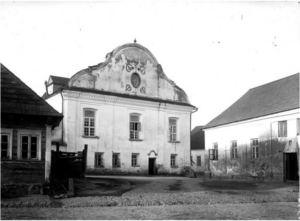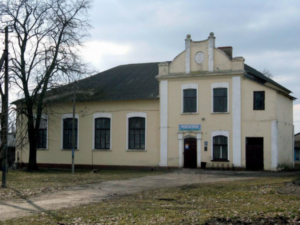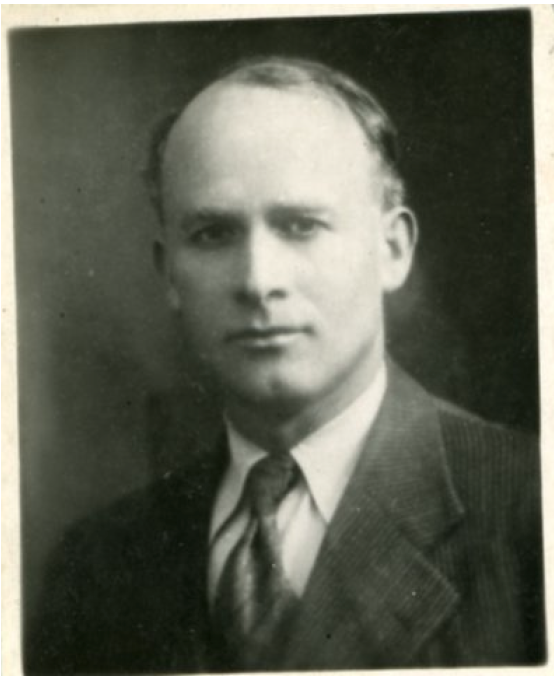David BLACHERE (Blakher) (1889-1945)
David Blachère (Blakher) was born 15 December 1889 in Kleck in Russian Empiure (now Minsk Province in Belarus). He died 23 march 1945 in Koncentration Lager Mauthausen, Austria.
Was the son Leibe Blachère (Blakert) died 1910, Warsaw, and Golde Adinska, died 1910 Kleck. He married Judith/ Yudis Nochimowski, born 30 march 1889, Lubcha, Navahrudak (Nowogrodek) Disctrick (now Belarus). She was a daughter Zvi Hirsch Nochimowski and Liebe Rochel Nochimowski. She died 9 march 1973, buried in the cemetery Montmorency Val-d’Oise in France.
David Blachère and Judith had two children: Léon Maurice, born 9 april 1912, Paris, died 21 march 2009, and Sonia Denise Blachère (Abrams), born october 1922, Paris, inhabited USA.


Family town XIX/XX. Jewish community in Kleck
The first mention of Jews in Kleck dates back to 1529 . There was a Jewish district in which, among others, synagogues and mikveh. According to the 1897 census, there were 3,415 Jews out of 4,684 inhabitants. They made a living from trade in agricultural products, oil production, milling and wool processing. There was a primary school with Hebrew as the language of instruction.
Before World War I the township of Kleck (Russian: Kletsk) was situated in Sluck district of the Minsk gubernia (province). In the 19th and early 20th century, the Jews accounted for the majority of Kleck’s inhabitants. Jewish schools in Kleck were attached to synagogues and private homes of the teachers (melameds). From 1878, an afternoon shift was introduced for boys of the Mosaic denomination at the Russian People’s School (narodnoye uchilishche). In 1906, a single-grade private Jewish school for boys was set up in Kleck, informally known as Kronicz’s School, Kronicz being the name of its owner.
As a result of the partitions of Poland in the eighteenth century, Kleck found itself in the Russian partition. After the end of the First World War and regaining independence by Poland, Kleck found itself within the borders of Poland (exactly as a result of the Treaty of Riga in 1921). After World War II, the city found itself again in the Byelorussion Soviet Socialist Republic. Since 1991 within the borders of Belarus.


Emigration to France
We know that members of the Blachère family in Kleck were selling, among others, groceries, and had a cloth factory. We do not know what exactly David Blachère did before leaving for France and what made him leave his hometown. He probably came to France with his wife Judith Nochimowski. According to the information, David Blachère left Kleck before the outbreak of the First World War.
However, we know from French archives that in 1912 the first son, Leon Maurice Blachère, was born.
October, 1925 David Blachère was naturalised.
Live in France and arrestation
Before 1939, David Blachère lived in Paris X: 140 Blv. Magneta. He owneda carpentry shop.
During the war David Blachère stayed with his family in Antibes. Last known residential address: Villa la Deulle-Avenue Pins Parasol in Juan les Pins (Antibes).
He was arrested as a result of a neighbor’s report to the Gestapo. David Blachère was accused of being the “head of the underground”. From 1941 he was in the Drancy camp. The family tried unsuccessfully to contact him.
David Blachère arrested in spring 1944, interned in Drancy. July 31, 1944 deported to Auschwitz in transport number 77. Then transferred to the camp in Mathausen, Austria. He arrived on the “death march” at the camp on January 25, 1945. His prisoner number: 123593. David Blachère died March 23, 1945. Cause of the death: general sespsis in phlegmon. His name was engraved on the memorial wall of Holocaust victims’ names in Paris (Le Memorial de la Shoah).


 Français
Français Polski
Polski









